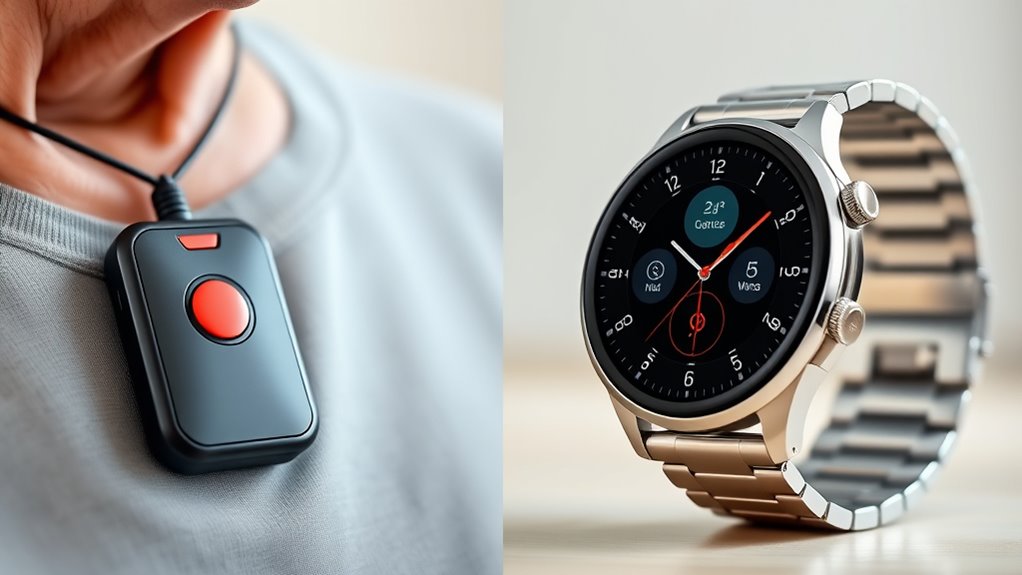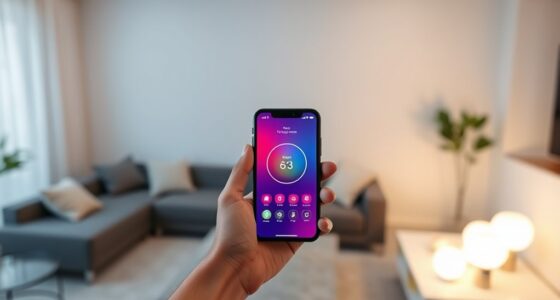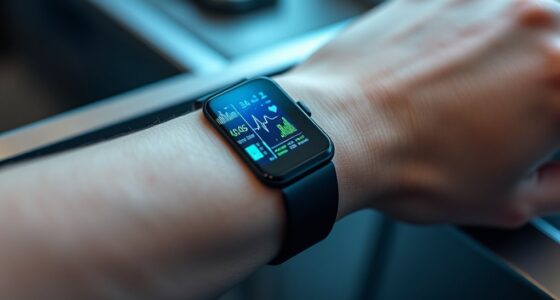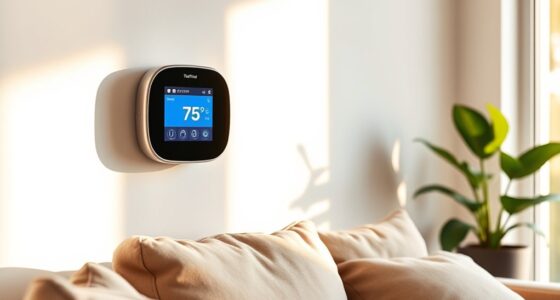Medical alert systems focus on providing quick emergency access with simple, reliable devices like pendants or wristbands, often with dedicated buttons and long-lasting batteries. Smart wearables offer broader health data tracking, activity monitoring, and more sophisticated features, usually connected to smartphones. They are more customizable but may require regular charging and can be less straightforward in emergencies. To understand how these options compare in detail, keep exploring the key differences.
Key Takeaways
- Medical alert systems prioritize quick emergency access with dedicated buttons and reliable communication, while smart wearables offer broader health tracking features.
- Alert systems usually have longer-lasting batteries focused on emergency use, whereas wearables may require frequent charging due to multiple functions.
- Medical alert systems often involve ongoing subscription fees for 24/7 monitoring, whereas wearables may have higher upfront costs but fewer recurring charges.
- Alert systems are designed for simplicity and immediate response, typically resembling a pendant or wristband, unlike the customizable, sleek design of smart wearables.
- Connectivity in alert systems is device-specific for emergency response, while wearables rely on smartphone or cellular networks, affecting response speed and reliability.
Purpose and Primary Functions

Medical alert systems are designed primarily to guarantee quick access to emergency help for individuals with health concerns or mobility issues. Their primary function is to connect users instantly to emergency services at the push of a button, ensuring safety and peace of mind. While fashion trends influence the look of some alert devices, many prioritize functionality over style, focusing on reliability. Battery life is essential; a long-lasting battery ensures the device remains operational during emergencies without frequent recharging. Unlike smart wearables, which often blend into daily wear and offer multiple features, medical alert systems are purpose-built for safety. Their main goal is immediate response and ease of use, making them indispensable for those who need quick assistance without worrying about device aesthetics or frequent charging. Additionally, some medical alert systems incorporate features like long-lasting batteries to maintain reliability during critical moments.
Design and Usability
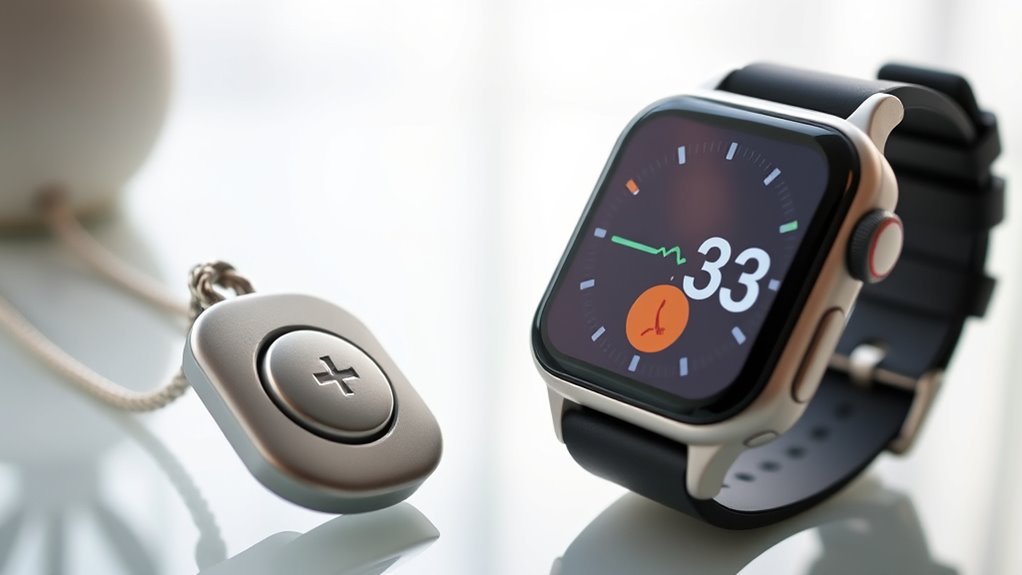
When considering design and usability, medical alert systems are built for simplicity and ease of operation. They typically feature a straightforward user interface, making it easy for you to activate help quickly, even in emergencies. The aesthetic appeal of these devices is minimal, focusing on functionality over style, often resembling a pendant or wristband. This ensures they’re unobtrusive and easy to wear daily. In contrast, smart wearables emphasize sleek design and user-friendly interfaces, blending technology with fashion. They often offer customizable options and intuitive controls, enhancing overall usability. While medical alert systems prioritize accessibility and quick response, smart wearables aim for a seamless, attractive experience that integrates smoothly into your lifestyle. Additionally, understanding city dynamics can help users optimize their device usage and integrate health monitoring features effectively.
Monitoring Capabilities and Features
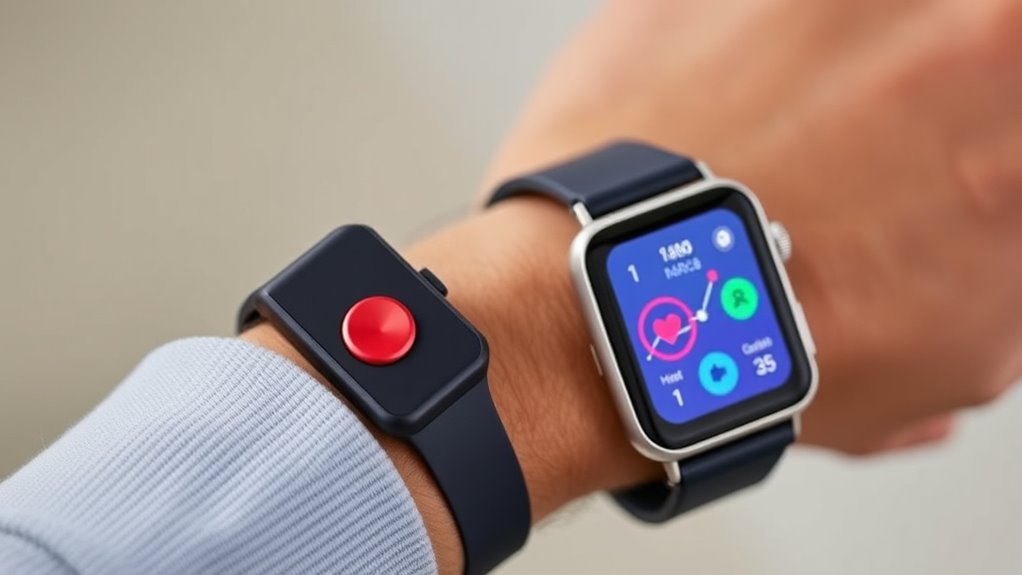
Monitoring capabilities and features vary considerably between medical alert systems and smart wearables. Medical alert systems typically focus on detecting emergencies like falls or abnormal heart rates, relying on sensors with high accuracy to guarantee prompt alerts. They generally have dedicated sensors optimized for specific health concerns, providing reliable monitoring. Smart wearables, on the other hand, offer a broader range of features, including activity tracking, sleep monitoring, and heart rate measurement, but sensor accuracy can vary depending on the device. Battery life also differs; alert systems often have longer-lasting batteries due to limited functions, while wearables may require more frequent charging because of their extensive features. Additionally, the sensor technology used in medical alert systems is specifically designed for precision in critical health situations, whereas wearables emphasize versatility and lifestyle integration. Your choice depends on whether you prioritize specialized monitoring or multifunctional health tracking.
Connectivity and Emergency Response

Connectivity and emergency response are critical factors that determine how quickly help can arrive when needed. Medical alert systems often have dedicated device integration, allowing seamless communication with emergency services or caregivers. Smart wearables, on the other hand, rely on your smartphone’s connectivity or cellular networks, which can vary in reliability. The user interface plays a crucial role here—an intuitive interface ensures you can easily activate emergency features without delay. Medical alert systems typically feature dedicated buttons and straightforward interfaces designed for urgent situations. Wearables may include voice commands or touchscreens, but these can sometimes be less accessible during emergencies. Overall, strong connectivity combined with a clear, user-friendly interface ensures prompt emergency response, giving you peace of mind wherever you are. Additionally, digital literacy programs help seniors become more confident in using these technologies effectively.
Cost and Subscription Requirements

Cost and subscription requirements can considerably impact your choice between medical alert systems and smart wearables. Medical alert systems often come with fixed pricing plans, including upfront device costs and ongoing subscription fees for emergency monitoring services. These subscription fees usually cover 24/7 response center access and can vary based on features. Smart wearables, on the other hand, might have a higher initial purchase price but often lack mandatory ongoing subscription fees, especially if they use your existing smartphone or Wi-Fi. Some wearables offer optional premium services with additional features, which come with extra costs. Carefully compare the pricing plans and subscription fees for each option to determine which aligns best with your budget and needs. Remember, ongoing costs can substantially influence your long-term decision. Additionally, understanding the cost structure of each device type can help you make a more informed investment.
Frequently Asked Questions
How Do Medical Alert Systems and Wearables Handle Data Privacy?
You should know that both medical alert systems and wearables prioritize data privacy by using data encryption to protect your information. They also require your explicit user consent before sharing any data, ensuring you’re in control. While wearables often store and sync data with other devices, alert systems focus on secure communication with emergency contacts. Always check each device’s privacy policy to understand how your data is handled and protected.
Can These Devices Be Customized for Specific Health Conditions?
Yes, these devices can be customized for specific health conditions through personalization options and device integration. You can tailor alerts, monitoring features, and data sharing settings to suit your needs. Many wearables and alert systems easily sync with health apps or medical devices, enabling you to track and manage conditions like diabetes or heart issues more effectively. This customization helps guarantee you get relevant support and insights for your unique health situation.
What Is the Typical Lifespan of Each Device’s Battery?
Did you know that smart wearables typically have a battery lifespan of 1 to 7 days? You need to focus on power management to maximize longevity, especially with frequent use. Medical alert systems usually last longer, up to several months on a single charge, thanks to simpler power needs. For both types, proper charging habits and device settings help extend battery life, so you stay connected when it matters most.
Are There Options for Non-Emergency Health Monitoring?
Yes, you can find devices that focus on non-emergency health monitoring and daily health tracking. Many smart wearables, like fitness trackers and smartwatches, offer features such as heart rate monitoring, sleep analysis, and activity tracking. These devices help you stay aware of your overall health without emphasizing emergency alerts. They’re ideal if you want continuous insights into your wellness and can motivate you to maintain healthier habits daily.
How Do Device Sizes Affect User Comfort and Discretion?
Device form factors greatly impact your comfort and discretion. Smaller, lightweight wearables often offer better wearable ergonomics, making them less obtrusive and easier to wear all day. Larger devices may feel bulky and draw attention, potentially reducing comfort and discretion. Choosing a device with ideal form factors ensures you stay comfortable while maintaining a low profile, so you can wear it confidently without feeling self-conscious or hindered in daily activities.
Conclusion
Choosing between medical alert systems and smart wearables is like picking between a trusty lighthouse and a versatile Swiss Army knife. Both guide you safely, but one shines with simplicity, while the other offers a toolkit of features. Think of it as finding your perfect sidekick—one that fits your needs and keeps you secure. Whichever you choose, you’re arming yourself with a guardian that stands ready, like a loyal friend, to light your way when it matters most.
